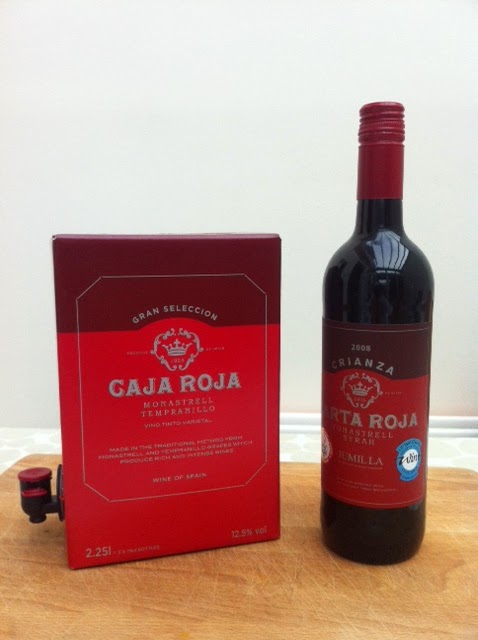When they said that drinking wine could leave you seeing double, this wasn't what I thought they meant.
I would not wish you to think that I blunder along the shelves of my supermarket blearily plucking in desperation at anything that reminds me of a bottle of wine.
But I have only the time it takes Mrs K to negotiate the bread and baking aisles, during which I am left in the wine section, to choose the week’s wine and to come up with a plausible story for purchasing it.
I’m looking for something that we really must have, we need to have, because of guests, or the weather, or something. And given the summer sun, what about that vinho verde from Azevedo I read about, lovely for drinking on its own in the garden. I recognise that tall bottle, that name, that label with an old building on it. And there can’t be that many items in the aisle with both ‘v’ and ‘z’ on their label, unless Sainsbury’s is now offering vajazzles.
Well. Of course, I was proven wrong. It turns out that what I bought is not the lovely Quinta de Azevedo, described as "Almost bone dry ... thirst-quenching ...sparky, floral, stone fruit” - Jane MacQuitty. Not the Quinta de Azevedo described as “Filigree-light, dry white with pure, clean flavours of pear, apple and lemon, and a delicate hint of spritz” – Suzy Atkins. No, this is Torre de Azevedo, described as “slightly syrupy, yellowish wine which gradually reveals, as the chill wears off, a certain slimy fruitiness, ending in an acidic attack to the throat like an onset of tonsilitis” – Sediment.
More fool me? Well sorry, but on a rushed morning in the supermarket, I didn’t expect to need a wine encyclopedia. I know, you shouldn’t judge a label by appearances, or a book by its cover – but if you see a book cover that looks like the one you remember, and it says JK Rowling on the spine, you’d be pretty copped off when you get home and realise it's an adventure of the lesser wizard Harry Pooter.
And this has happened to me before. Previously, in a short-lived exploration of wine in a box. I made the mistake of thinking that Caja Roja, in a box, was the same as the similarly packaged Carta Roja, in a bottle. I submit, m’lud, that any harrassed shopper would assume these two are the same wine:
They are not.
Am I the only person who is falling foul of this? The marketing people worry about wine being baffling to the average consumer – and then set them what amounts to a spot-the-difference test.
The discount store Lidl, for example, is planning to target upmarket London wine drinkers with some classy Bordeaux. ‘Lidl claret offensive’ said one headline, a statement which I felt read more like a tasting note than a marketing strategy.
Lidl will be selling, at £13.99, a wine from Chateau Siaurac, No, it’s not Chateau Siaurac itself; nor is it the second wine of Siaurac, which is Plaisir de Chateau Siaurac. But the ‘Reserve de la Baronne’ certainly looks like them:
Perhaps you can pick it out from the Chateau Siaurac line-up:
So before deciding whether a wine is the one you think it is, you have to master some kind of identification parade. A general memory of a name and a label, as I discovered, is no longer enough.
You can’t just send someone down the road to buy a bottle of wine based on your description of the label. “Oh, pick up a bottle of that red – it has a white label with a sort of circular device in red, like a Celtic symbol or something…” They might pass The Good Wine Shop, and bring back the bottle of Clonakilla, which you meant – or they might pass Oddbins, and bring back The Good Templar. Which you didn’t.
And a little knowledge can sometimes be more misleading than useful. I know, for example, of Chateau Ygay, a magnificent Rioja which I’ve tasted but can’t afford. So a label with similar type practically leaps at me from the Waitrose shelf:
The distinctive swirly red lettering, the additional gold swirly subtitle…could the significantly cheaper El Patito Feo perhaps be Ygay’s second wine? Are they by any chance related?
No, sadly not. El Patito Feo is not even a Rioja; it’s actually from a different area of Spain. And while this upstart may be from the same country, it is not in the same Liga as Ygay.
No wonder people get taken in by fake wines, when it’s so easy to mistake the real ones. Confused at first sight, it’s little wonder some of us end up buying not quite the wine we thought.
Heaven forbid it could ever be a deliberate ploy…
PK






That IWSC label on the Torre de Azevedo was surely the give-away...
ReplyDeleteAh yes! 5 bonus i-Spy points!
DeleteCaja roja means red box, which might explain the name change. According to their website, the grape variey is Syrah in the bottle, Tempranillo in in the box. I assume the Syrah is better?
ReplyDeleteYes, I did explore the whole carta/caja confusion here: http://sedimentblog.blogspot.co.uk/2013/09/turning-on-box.html
Deletealong with the additional fact that roja is not rioja. Baffling stuff, this wine business...
The bottle, Carta Roja, is actually a monastrell/syrah blend, and all the better for it. Not to be confused itself with its slightly posher and more expensive Gran Reserva, which is not actually as good! Carta Roja is frequently on offer at 2 for £10, and a very satisfying buy at the price!
PK